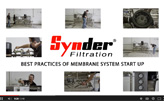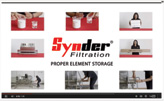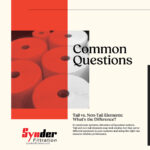Common Questions: Tail vs. Non-Tail Membrane Elements
Common Questions: Tail vs. Non-Tail Membrane Elements
In membrane filtration systems, the way an element fits inside the pressure vessel has a direct impact on performance. One of the most common questions we receive is the difference between Tail and Non-Tail elements, since both look similar but serve slightly different functions.
Choosing the correct type helps ensure proper sealing, stable flow, and long term membrane integrity.
What Is a Non-Tail Element?
A Non-Tail Element is Synder’s standard spiral wound membrane. These elements are designed to fit snugly inside most vessels without modification and are used in all positions except the very end of the housing.
A proper fit is important. If a membrane is too loose inside a vessel, issues may occur such as:
- Liquid bypassing the element rather than flowing through the membrane
- Lower permeate flow and reduced flux
- Faster fouling and more frequent cleaning
- Longer cleaning times and higher CIP costs
- Possible physical distortion inside the vessel, such as buckling, wrinkling, or channeling
Non-tail elements are built for consistent flow and stable performance throughout the majority of the system.
What Is a Tail Element?
A Tail Element includes a thicker outer wrap and reinforced tape, giving it a tighter and more secure wind. This is commonly referred to as a “trim to fit” model.
Inner diameters can vary slightly between vessels, and the additional wrap allows customers to trim the outer layer as needed to achieve a snug fit in the final position of the pressure vessel.
Key differences from a Non-Tail Element:
- Thicker outer wrap
- Reinforced and tightly wound construction
- Designed for trimming to match vessel tolerance
- Typically used at the end of the vessel where sealing is most critical
Tail elements help limit internal bypass and maintain stable recovery at the system outlet.
Why the Difference Matters
Even small variations in membrane fit can influence system performance. Using the appropriate element type helps ensure:
- Reliable sealing inside the pressure vessel
- Consistent permeate and concentrate flow
- Reduced risk of fouling or element deformation
- Improved long term efficiency and membrane life
Both options serve important roles in system design, and selecting the correct type based on vessel tolerances and position helps avoid operational issues.
Have Questions About Which Element You Need?
Whether your system requires standard Non-Tail elements or a tailored fit using a Trim to Fit Tail element, our team can help you determine the right configuration based on your housing dimensions and process requirements.
Contact your Synder representative or reach us at
sales@synderfiltration.com.
Learn more at synderfiltration.com.
questions? Fill out this form. We'll contact you within 24 hours!
CASE STUDY
Applications
Resources
MEMBRANE RESOURCES
- Definition of a Membrane
- Membrane Materials: Organic vs. Inorganic
- Pressure-Driven Membrane Filtration Processes
- Concentration Polarization in Pressure-Driven Processes
- Degrees of Membrane Separation
- Flux Behavior in Membrane Processes
Module Configurations & Processes
-> View all membrane resourcesTUTORIALS












